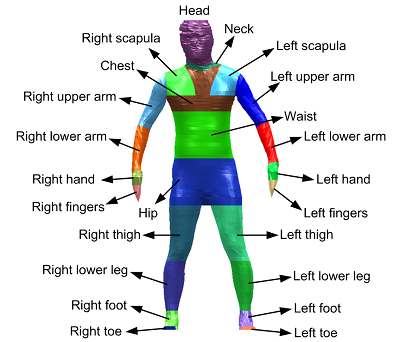Point-Structured Human Body Modeling Based on 3D Scan Data
Keywords:
3D body model, body motion animation, feature recognitionAbstract
A novel point-structured geometrical modelling for realistic human body is introduced in this paper. This technique is based on the feature extraction from the 3D body scan data. Anatomic feature such as the neck, the arm pits, the crotch points, and other major feature points are recognized. The body data is then segmented into 6 major parts. A body model is then constructed by re-sampling the scanned data to create a point-structured mesh. The body model contains body geodetic landmarks in latitudinal and longitudinal curves passing through those feature points. The body model preserves the perfect body shape and all the body dimensions but requires little space. Therefore, the body model can be used as a mannequin in garment industry, or as a manikin in various human factor designs, but the most important application is to use as a virtue character to animate the body motion in mocap (motion capture) systems. By adding suitable joint freedoms between the segmented body links, kinematic and dynamic properties of the motion theories can be applied to the body model. As a result, a 3D virtual character that is fully resembled the original scanned individual is vividly animating the body motions. The gaps between the body segments due to motion can be filled up by skin blending technique using the characteristic of the point-structured model. The model has the potential to serve as a standardized datatype to archive body information for all custom-made products.
References
M. Petrov, A. Talapov, T. Robertson, A. Lebedev, A. Zhilyaev, and L. Polonskiy, “Optical 3D digitizers: Bring life to the virtual world,” IEEE Computer Graphics and Application, vol. 18, no. 3, pp. 28-37, May 1998.
Cyberware, http://www.cyberware.com, 2012.
TC2, http://www.tc2.com, 2012.
Vitus, http://www.vitronic.de, 2012.
Creaform, http://www.creaform3d.com, 2012.
J. H. Nurre, J. Connor, E. A. Lewark, and J. S. Collier, “On segmenting the three-dimensional scan data of a human body,” IEEE Transactions on Medical Imaging, vol. 19, no. 8, pp. 787-797, August 2000.
X. Ju, N. Werghi, and J. P. Siebert, “Automatic segmentation of 3D human body scans,” Proc. of IASTED Int. Conf. on Comp. Graphics and Imaging, 2000.
K. Robinette, M. Boehmer, and D. Burnsides, “3-D landmark detection and identification in the CAESAR project,” Proc. 3rd Int. Conf. on 3-D Digital Imaging and Modeling, pp. 292-298, 2001.
R. P. Pargas, N. J. Staples, and J. S. Davis, “Automatic measurement extraction for apparel from a three-dimensional body scan,” Optics and Lasers in Engineering, vol. 28, no. 2, pp. 157-172, September 1997.
M. J. Tsai, Z. P. Chen, and Y. S. Liu, “A study on the automatic feature search from 3D body scanners,” Proc. of the 20th National Conference, Society of Chinese Mechanical Engineering, Taipei, December 2003.
I. F. Leong, J. J. Fang, and M. J. Tsai, “Automatic body feature extraction from a marker-less scanned human body,” Computer-Aided Design, vol. 39, no. 7, pp. 568-582, July 2007.
M. J. Tsai and J. J. Fang, Feature based data structure for computer manikin, US Patent, 7,218,752 B2, May 15 2007.
L. A. Wang, W. M. Hu, and T. N. Tan, “Recent development in human motion analysis,” Pattern Recognition, vol. 36, no. 3, pp. 585-601, March 2003.
J. K. Aggarwal and Q. Cai, “Human motion analysis: A review,” Computer Vision and Image Understanding, vol. 73, no. 3, pp. 428-440, March 1999.
T. B. Moeslund and E. Granum, “A survey of computer vision-based human motion capture,” Computer Vision and Image Understanding, vol. 81, no. 3, pp. 231-268, March 2001.
R. Poppe, “Vision-based human motion analysis: An overview,” Computer Vision and Image Understanding, vol. 108, no. 1-2, pp. 4-18, October-November 2007.
International Organization for Standardization, Garment construction and anthropometric surveys – body dimensions, Reference No. 8559-1989, Switzerland: ISO, 1989.
ASTM, Standard terminology relating to body dimensions for apparel sizing, ASTM Designation: D 5219-99, USA, 1999.
M. J. Tsai, H. W. Lee, and H. Y. Lung, “Feature-based data structure for digital manikin,” U.S. Patent, US 20130069936 A1, March 21, 2013.
M. J. Tsai and H. Y. Lung, “Two-phase optimized inverse kinematics for motion replication of real human models,” Journal of the Chinese Institute of Engineers, vol. 37, no. 7, pp. 899-914, April 2014.
M. J. Tsai, J. H. Chao, and T. W. Yang, “Construction of a general motion editing system for human body and humanoid robots,” Proc. ASME 2014 Int. Design Engineering Technical Conf. & Computers and Information in Engineering (IDETC/CIE 2014), ASME Press, August, 2014, pp. V01AT02A072.

Published
How to Cite
Issue
Section
License
Submission of a manuscript implies: that the work described has not been published before that it is not under consideration for publication elsewhere; that if and when the manuscript is accepted for publication. Authors can retain copyright in their articles with no restrictions. is accepted for publication. Authors can retain copyright of their article with no restrictions.
Since Jan. 01, 2019, AITI will publish new articles with Creative Commons Attribution Non-Commercial License, under The Creative Commons Attribution Non-Commercial 4.0 International (CC BY-NC 4.0) License.
The Creative Commons Attribution Non-Commercial (CC-BY-NC) License permits use, distribution and reproduction in any medium, provided the original work is properly cited and is not used for commercial purposes.



